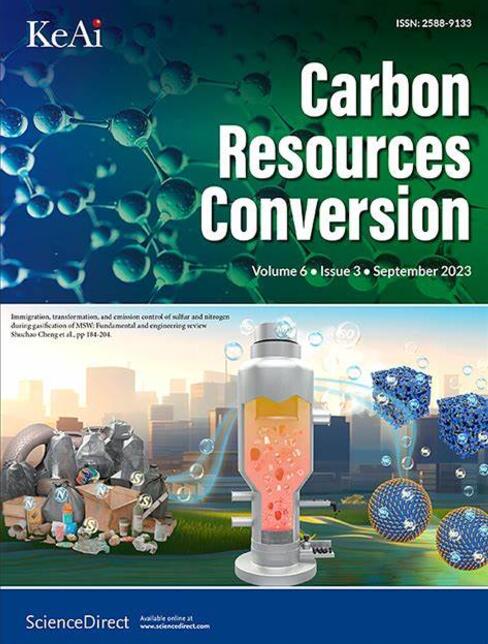Pyrolysis of biomass to produce H-rich gas facilitated by simultaneously occurring magnesite decomposition
IF 7.5
3区 环境科学与生态学
Q2 ENERGY & FUELS
引用次数: 0
Abstract
This study investigated how biomass pyrolysis varies with the different fractions of magnesite mixing into biomass. The pyrolysis occurred with simultaneous decomposition of magnesite without use of any gasification reagent, and was analyzed in terms of producer gas yield and quality. As magnesite fraction increased from 0 to 30 %, the yield of producer gas and its calorific value increased from 48.6 % to 66.3 % and 8.29 to 8.93 MJ/Nm3, respectively. The carbon and hydrogen conversion increased from 44.1 % to 60.7 % and 43.1 % to 66.2 %, respectively. The characterization results revealed that magnesite particles facilitated the conversion of fixed carbon and the thermal/catalytic cracking of tar to produce H-rich gas. The in-situ generated CO2 from magnesite decomposition could be reduced to CO/CH4 in the reductive atmosphere of the pyrolysis products. This study proposes the concept of converting low-energy–density biomass into gas without oxygen and provides a novel approach for producing H-rich gas from biomass.
同时发生的菱镁矿分解促进生物质热解以产生富含 H 的气体
本研究考察了不同菱镁矿加入量对生物质热解的影响。在不使用任何气化剂的情况下,在菱镁矿同时分解过程中进行热解,并对产气率和质量进行了分析。当菱镁矿馏分由0增加到30%时,产气产率和热值分别由48.6%和8.29提高到66.3%和8.93 MJ/Nm3。碳和氢的转化率分别从44.1%提高到60.7%和43.1%提高到66.2%。表征结果表明,菱镁矿颗粒促进了固定碳的转化和焦油的热裂解/催化裂解生成富氢气。菱镁矿分解生成的CO2在热解产物的还原性气氛中被还原为CO/CH4。本研究提出了将低能量密度生物质转化为无氧气体的概念,为生物质生产富氢气体提供了一种新的途径。
本文章由计算机程序翻译,如有差异,请以英文原文为准。
求助全文
约1分钟内获得全文
求助全文
来源期刊

Carbon Resources Conversion
Materials Science-Materials Science (miscellaneous)
CiteScore
9.90
自引率
11.70%
发文量
36
审稿时长
10 weeks
期刊介绍:
Carbon Resources Conversion (CRC) publishes fundamental studies and industrial developments regarding relevant technologies aiming for the clean, efficient, value-added, and low-carbon utilization of carbon-containing resources as fuel for energy and as feedstock for materials or chemicals from, for example, fossil fuels, biomass, syngas, CO2, hydrocarbons, and organic wastes via physical, thermal, chemical, biological, and other technical methods. CRC also publishes scientific and engineering studies on resource characterization and pretreatment, carbon material innovation and production, clean technologies related to carbon resource conversion and utilization, and various process-supporting technologies, including on-line or off-line measurement and monitoring, modeling, simulations focused on safe and efficient process operation and control, and process and equipment optimization.
 求助内容:
求助内容: 应助结果提醒方式:
应助结果提醒方式:


